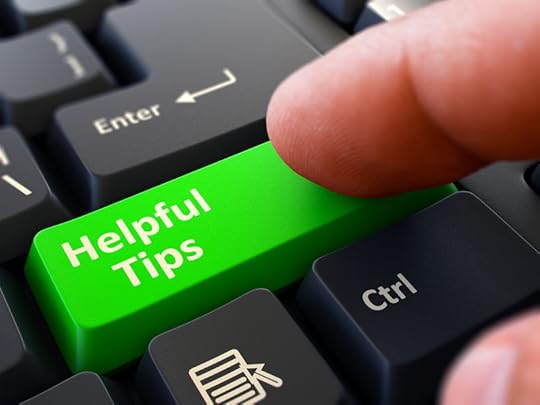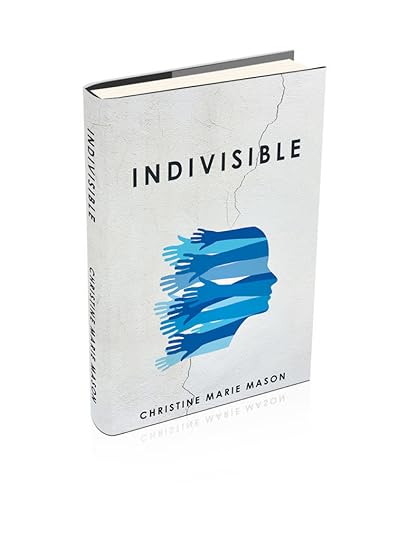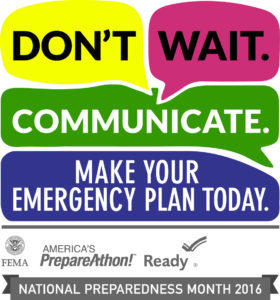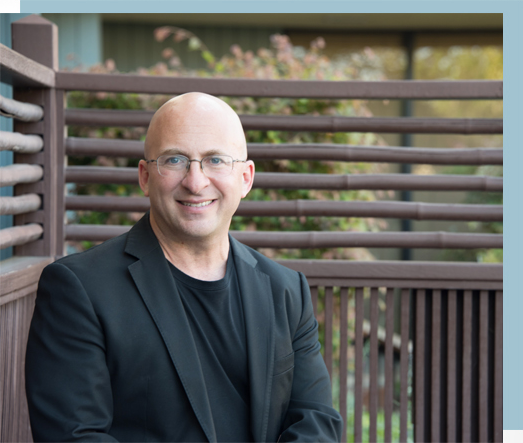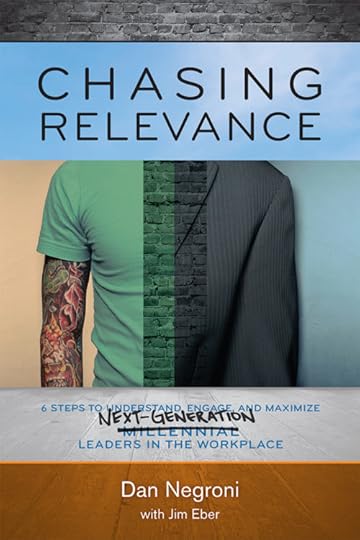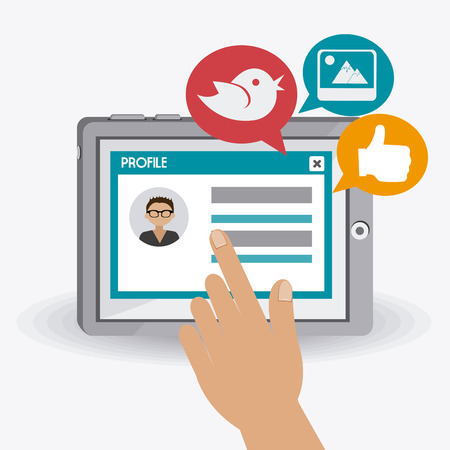Becky Robinson's Blog, page 53
September 20, 2016
Making the Grade on HAROs—6 Tips for HARO Success
In almost every group project I was ever involved with in school, from elementary through graduate level, there was always someone who took on the lion’s share of the work and someone who didn’t pull their weight.
When it comes to putting together a news story these days, it seems like the roles of the ever-familiar school group project are emerging again. This time, it often appears that the public relations person or interview subject is doing all the work while the reporter or writer sits back and takes the Pgrade—and byline.
But it’s important to note that, in an age of around-the-clock news and slim newsroom staffs, journalists’ jobs are more challenging than ever before. So they aren’t really slacking. They just need your help.
As Peter Shankman reportedly put it:
“In the past ten years, journalists have been tasked with doing ten times more with five times less. Truly want to get your story placed? Do as much of the journalist’s work as you can. Give smart background. When you offer a source, make sure they can talk and know what they’re saying. Beat the herd by being just a little bit better.”
Shankman is the founder of Help A Reporter Out, or HARO, a source for news people to find sources for their stories quickly.
If you are a Weaving Influence public relations client, chances are you are familiar with HARO and ProfNet, another media query service. You know that these services provide a real opportunity for you to tap into the news coming out of your industry. By landing in a story, you earn often high-profile publicity, relationships with key media contacts, and backlinks to your website, to name a few benefits.
But there are right ways and wrong ways to respond to a HARO. The Weaving Influence PR team is skilled at making sure we respond in a way that gets media personnel’s’ attention (like writing catchy headlines), showcases your expertise (credentials in the first paragraph, bio at the very end), builds relationships (personalized greetings), boosts SEOs (backlink requests), and doesn’t annoy contacts (no follow-ups unless the journalist contacts you), for example.
Yet responding to a HARO is often a team effort. And with that, there are some things experts should know when responding to queries sent from the PR team.
Here are 6 key tips for a successful HARO response:
Be really fast. Journalists get upwards of a hundred responses to a single query. And with a deadline looming, they often use the first responses they get for their stories. So time is of the essence when responding to a query.
Stick to the script. Answer exactly what they asked for. Don’t respond with something that is tangentially related or suggest another angle. If there are numerous questions, it is best to list the questions with your response below. The easier to read, the better.
Be short and sweet. Make your point quickly. Often, reporters even include a word limit to encourage this. The shorter, the better.
Be reachable. Journalists want to be able to get to you directly, so be open to including your email and phone number so that they can contact you for follow-up questions.
Be specific. Give specific points and ditch the generalities. If you’re including tips, aim for 3 to 5. But remember to follow the instructions of what the reporter asked for.
Give them what they need. Remember, your job is to make it easy on the reporter. So don’t ever tell them to go elsewhere for the information, like your website or another article.
There is never a guarantee that a HARO or ProfNet response will make it into a story, but by following these tips when you send your insights to your PR team member, your chances of making the grade will be much greater.
Image Credit: tashatuvango / 123RF Stock Photo
September 16, 2016
Featured on Friday – #Indivisible with @Xtinem
The anniversary of September 11th this past weekend was a huge reminder to me of the brokenness in the world. As I look back at the past several months, the violence seems to be increasing. I talk to people every day who feel alone, disconnected, and depressed.
That’s why I was so excited to learn I’d be working with Christine Mason on the launch of her book, Indivisible: Coming Home to Our Deep Connection. Christine digs deep into these issues and more as she explores the power of connection.
“We are never separate or alone. Let us be brave together, reconnect, & reweave a culture and a world that works for everyone.” – Christine Mason
MEET CHRISTINE MASON
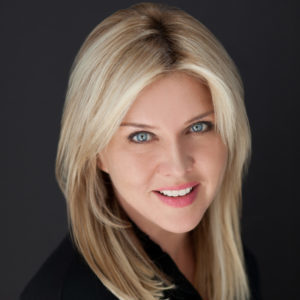 Christine’s life is inspirational. She has been a leader in the tech sector for 20 years, as the venture backed founder and CEO of several companies. She has always been a convener, bringing people together to have conversations around growth and change, and to spark action around new possibilities. She is the curator of 9 TEDxs, the convener of Naked Conversations and founder of LoveSpring.
Christine’s life is inspirational. She has been a leader in the tech sector for 20 years, as the venture backed founder and CEO of several companies. She has always been a convener, bringing people together to have conversations around growth and change, and to spark action around new possibilities. She is the curator of 9 TEDxs, the convener of Naked Conversations and founder of LoveSpring.
Her own deep journey exploring anger, violence and disconnection in the aftermath of her mother’s murder, early abandonment and general chaos have propelled her explorations into the interior life and capacity of the individual to heal and connect; her work as a victims’ right advocate for restorative justice and prison reform; and as an investigator into the neuroscience of human evolution and behavioral change.
She has lived and traveled all over the world, and speaks French and German. She is a yoga teacher and musician. She’s mother to 4 of her own children, and co-parent to 2 girls. Read more at xtinem.com and connect with her on Twitter.
LEARN MORE ABOUT INDIVISIBLE
There are more people living alone than at any time in history, and more depression than ever recorded. Violence to each other and ourselves continues to cast long shadows across generations. We are fragmented individually and collectively to the point of vile speech and hate crimes based on false divisions. How do we heal? How do we become more connected?
Indivisible is a transformational story of a deep human journey to the heart of connection.
Christine asks questions such as: Why are people lonely and alienated from one another? Why are people angry? Or mean? Or violent to each other? Is that reversible? Why do we lie and hide our true selves? How do we make more love and less conflict happen? Can we make a world that works better for all of us? How might we shift our internal state and the design of our communities and institutions to be happier, more connected?
Check out what some of our Buzz Builders have to say about Indivisible…
“This book was absolutely awesome. In fact, I tweeted that the book ‘rocked my world.’ There were so many things that resonated with me as an educator and leader… You will find the learning facilitated by this book to be useful in your professional life as well as your personal life.” {Read the rest of Dr. Byron L. Ernest’s review on Amazon.}
“Very few books stay with me the way Indivisible has. It is well worth reading and re-reading.” {Read the rest of Dawn-Marie Cornett’s review on Amazon.}
JOIN THE CONVERSATION
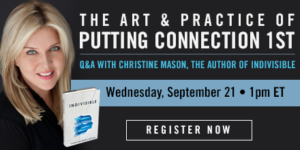 Christine will be joining Becky Robinson for an interactive discussion on The Art and Practice of Putting Connection 1st on September 21. If you are interested in learning more about a better way to live, join us for this live online conversation.
Christine will be joining Becky Robinson for an interactive discussion on The Art and Practice of Putting Connection 1st on September 21. If you are interested in learning more about a better way to live, join us for this live online conversation.
Register here.
SUPPORT THE LAUNCH
Buy the book if you haven’t already!
Leave a review — we love reviews, and can never see enough of them on Amazon!
Write about it on your blog and send us the link so we can share it.
Add it to your Goodreads shelf for others to find.
September 15, 2016
Great Things Happen When We Let Go of Knowing How to Do It
This post is part of our 2016 Team Buzz Builder Guest Blogger series. Today we are pleased to introduce you to Juan Arroyo.
This one is a lesson in story form.
In February 2015, I was getting certified as a John Maxwell Team coach, speaker and trainer. Everything was going well until Paul took the stage and said: “Suspend the requirement of knowing how.”
As soon as I heard it, my brain gave me the blue screen of death: “DOES NOT COMPUTE!”
I was born and raised to have a plan and be prepared for everything, because there’s always a formula or process to follow in order to get it right.
I have to admit, I was somewhat angry at Paul, because he was challenging my deeply held beliefs.
Notwithstanding, time passed and I forgot about Paul’s words.
Fast forward to one year later, February 2016.
I’m in Paraguay with 260 other coaches looking to make a difference under one simple motto: “We are going to some place, at some time, to meet someone, and do something.”
So, I’m there excited and afraid. We are all in a room getting to know each other when Paul takes the stage to give an impromptu announcement: “We need 13 Spanish speaking coaches to travel overnight to unscheduled destinations, please come forward for a debrief!”
Without thinking about it, I stood up and walked to the front with determination. Yet, I couldn’t ignore the voice in the back of my head saying, “What in the world are you thinking, Juan!”
At any rate, I did it. I traveled 4 hours by car to work with a cooperative formed by families of German descent. Go figure, my very first time training and I end up delivering it to people that have Spanish as their second language!
With that adventure finished, I got back the Asunción to continue with the “scheduled programming.”
The way it worked was this: you ate breakfast, you got in line, and someone came to pick you up and take you some place, at some time, to meet someone, and do something.
This time around, I got to visit the Paraguayan consulate.
As you may expect, things didn’t go as planned. We took materials for a half-day session and we quickly found out we were going to be there all day. In the middle of the confusion, I somehow ended up leading the group and organizing the entire engagement.
In fact, I connected so well with the organizer, Diego, that I ended up telling him, “I don’t know how I’m going to do it, but I’ll come back tomorrow.”
Not only did I go back, but thanks to my connection with Diego and his staff, they gave me the opportunity to train their executive team, including a congresswoman.
What a great experience and story to tell. I was part of the start of a movement that trained close to 19,000 people in 4 days.
But you want to know what’s the most amazing about it?
It wasn’t until I was flying back to the US that I realized the only thing that made it possible was my willingness to suspend the requirement of knowing how.
What’s the lesson? Don’t let the need to know how to do something stop you from living a life of significance.
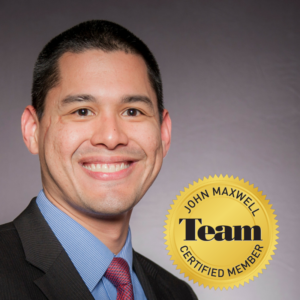 Juan Arroyo wakes up every day looking for the questions that allow an individual to break through a self-limiting belief and become the best version of oneself. He’d love to connect with you and help you reach a higher level of awareness through his blog, or via twitter.
Juan Arroyo wakes up every day looking for the questions that allow an individual to break through a self-limiting belief and become the best version of oneself. He’d love to connect with you and help you reach a higher level of awareness through his blog, or via twitter.
Image credit: geralt
September 13, 2016
The Lowdown on Lead Magnets
When we discuss new website projects with clients, we like to be straightforward about one thing: just because you build it, doesn’t mean they will come. There are millions (if not billions) of websites on the web, so you better have a solid plan for attracting interest and engagement.
Building and maintaining a relationship with readers on your site is a process that can involve a number of different strategies. In this post, I am going to discuss one such strategy: the lead magnet.
What is a lead magnet?
A lead magnet is a resource offered in exchange for contact information, which is used to convert visitors to your website into leads (most likely through email marketing). A good lead magnet should offer something of real value while establishing credibility.
The ultimate goal of a lead magnet is to build your email list which, in turn, can increase your conversion rate (the percentage of users who take a desired action). You may want your lead magnet to help you gain more business or to build community around a thought or idea. Whatever your goal is, having a strong lead magnet will help your website work with you to accomplish that goal!
Choosing a Topic
“What does my target audience want to know more about?”—this should be the first question you ask yourself when selecting a topic for your lead magnet. Not sure? Check out what your competition is offering. Of course, your lead magnet should be uniquely focused on what you have to offer. It should give visitors to your site a taste of what you can do, leaving them interested in learning more.
Your lead magnet can be in a variety of forms, depending on what would be most valuable to your target audience.
Here are some examples:
Sample chapter or e-book
Many Weaving Influence clients will offer a free sample chapter or e-book, since they are trying to establish themselves as authors and thought leaders in their fields. Keep in mind, though, that most people visiting a website do not have a lot of incentive to spend time reading a long e-book or sample chapter. If you do go this route, try to keep the lead magnet as brief as possible, and include in the lead magnet description a solid reason as to why this information is worth reading. For example: “Sign up to receive a free sample chapter from my book that will teach you 5 easy ways to quadruple your income in a week.” Cheryl Bachelder does a great job using an e-book to encourage sign-ups on her site.
Resources
If you don’t have a lot of time to invest in your lead magnet but still want to offer some real value, consider composing a simple list of highly valuable resources that your target audience will find helpful (online tools, articles, podcasts, etc.). For example: “Sign up to receive the freelance writer’s online toolbox for free, a select list of recommended resources for getting your freelance writing business up and running this quarter.”
Drip email course or video course
If you choose to create some kind of course or series of videos for your lead magnet (you can use a variety of emailing services to do this—we recommend Mailchimp or Infusionsoft), be sure to focus on helping solve one or more of your customers’ most urgent problems.
Quiz
A quiz can be a fun and engaging way to help your audience understand something fundamental about themselves and the way they conduct business. Everyone loves learning about themselves—use this to draw them into your ideas and services.
Article/whitepaper/case study, etc.
Any document that would prove valuable to your audience can be used as a lead magnet. Like with the sample chapter or e-book, be careful that the information is relevant and concise. Giant Leap Consulting does a great job of encouraging sign-ups by offering a free strategic planning workbook as their lead magnet.
Newsletter
Though most online brands offer some kind of regular updates or newsletter via email (and most people’s inboxes could stand a round of unsubscribes), a newsletter can still be an excellent lead magnet. Clearly state the value of your newsletter and consider adding in text about the frequency of delivery. For example, someone is much more likely to sign up for “A 150 word weekly marketing tip” than “A weekly post from my blog.” Author John Perkins has an engaging newsletter sign-up on his website.
A few words on positioning
Your lead magnet should be visible on highly-trafficked areas of your site, most likely the home page and the blog (if you have one). It should serve as a way for visitors to your site to get more acquainted with you and your work. You can see a great example of lead magnet positioning on consultant Ken Rutsky’s homepage.
Measuring Success
How do you know if your lead magnet is doing the job you intended it to do? Ask the following questions:
Do visitors to your site opt into your list?
Do they stay subscribed once they are on the list?
Are you getting an increase in interest and ultimately business (this may take several months to measure)?
Interested in developing an online strategy, including a lead magnet for your website, but not sure where to start? Learn more about Weaving Influence’s services and contact our team—we’d be happy to help!
Image courtesy of Pixabay
September 9, 2016
Featured on Friday: Reflecting on September 11
“What did we do when September 11 happened?”
It was so ironic that my daughter, Tenley, now 20 years old, asked me that recently. Only a few weeks prior, I had spoken about Sepember 11, 2001, to a local reporter who had asked parents to discuss how to share difficult information with their children in the aftermath of the Orlando Pulse shooting.
Having been a five-year-old kindergartner on September 11, 2001, Tenley’s specific memories of that day are vague.
However, she loves New York City; we have gone roughly every two years starting when she was 18 months old. We visited the site of the World Trade Center in 2002 when she was six. We visited the 9/11 Memorial after her high school graduation.
Although my age-appropriate explanation to my five-year-old was basic and brief, as she grows into adulthood, I will encourage her to do what the 9/11 Memorial encourages: remember, reflect, and serve as we look back fifteen years later on what transpired in New York City; Washington, DC; Shanksville, PA; the entire nation; and the world that day.
I have chosen quotes and examples from among current and former members of our Weaving Influence family to reinforce each one.
Remember
It is imperative to remember the events of that day, and the unique features of each victim that made them valued friends, coworkers, family members, and citizens. For those who are too young to remember, we can teach them.
In his post Leaders: What is Your Expression?, Paul Larsen reminds us:
Your leadership footprint isn’t made of sand.
Although thousands lost their lives that day, each one leaves behind a permanent legacy. It will not shift or blow away as sand does. These legacies are cemented into our national consciousness; their names are engraved on the solid marble of the memorial.
No day shall erase you from the memory of time. – Virgil
Reflect
An event of such enormity challenges us to focus our reflections. The passage of time prismatically modifies the rawest of our emotions; it equips us with enough perspective (hopefully) to move back into our routine days while continuing to grieve and remember; but our reflections on 9/11 should always redirect us back unity rather than division.
Although Karin Hurt was referring to the types of surprises that bring unexpected joy rather than an abrupt descent into sorrow, in Why to be Surprised: The Power of Not Knowing, she touches on a truth of September 11:
The biggest life and leadership lessons come when you’re surprised.
Would we all prefer to have avoided the difficult life lessons we learned as individuals and a nation that day and in its aftermath? Absolutely. Can our reflections on how we came together spur us on to be better people? They can and they should.
Serve
The last of the three recommendations from the 9/11 Memorial is to serve. Through serving on September 11 (and year-round), the tragedy of the day can be channeled in a positive way. Service is a way we can collectively honor September 11 and put hands and feet to our remembrances and reflections.
Perhaps you have been thinking of an ambitious service project and can’t quite get your head around how to begin. In Launching Your Big Idea, Linda Freeman reminds us that big ideas are not unattainable. She encourages three steps:
Start alone. Don’t wait for others to completely understand or agree before you take the first action. Get started.
Fight fear. You might not have everything you need when you start working on your Big Idea. You might feel fear and/or anxiety about moving forward. Remember that fear is just a feeling and feelings aren’t reality.
Push through. Your Big Idea can never come to life by simply thinking about it or talking about it. You have to work at it. Push yourself to keep going.
You may prefer to take smaller steps of service. That’s fine! Cheryl Bachelder, in Imagine the Impact of Your Work, elegantly explains how even the smallest of actions can have ripple effects (and bring joy to the volunteer), depending on how the volunteer perceives their own work.
Honor by Serving
The events of September 11, 2001, had the potential to destroy us as a country. But resilience and love prevailed. As Beau Sides writes in The Gingko Tree, “to say the ginkgo is a hearty tree would be an understatement. Extreme examples of the ginkgo’s tenacity may be seen in Hiroshima, Japan, where six trees growing between 1–2 km from the 1945 atom bomb explosion were among the few living things in the area to survive the blast. “
The ginkgos, though charred, survived and were soon healthy again. The trees are alive to this day.
Through our continued service on September 11, 2016, and for all the September 11’s to come, we can keep the legacy of the victims of September 11 alive.
My friend Gabrielle lost her uncle and godfather on September 11, 2001. She writes: “I belong to a club that nobody wanted to join — a group of 9/11 family members and survivors who cope with grief in our own ways. For me, the experience was motivation to give more of my time to causes important to me including working with veterans, animals and people with disabilities. My therapy dog and I spend a few days every week visiting hospital patients and our Alzheimer’s group.”
The Corporation for National and Community Service provides volunteer ideas here.
This September 11, how will you remember, reflect, honor, and serve?
Image credit: MonicaVolpin
September 6, 2016
Heeding the Lessons of Hermine
Want to know what will make you immediately focus your thoughts on the topic of “preparedness”? A direct hit by a Category One hurricane, that’s what!
When Hurricane Hermine came ashore near Tallahassee early in the morning on September 2, it was immediately apparent that for many of our city’s residents, the “labor” in “Labor Day” on September 5 would involve hauling fallen branches, doing emergency repair work on homes split apart by toppled trees, extracting water from flooded homes and businesses, and checking on the elderly and infirm. As I write this, nearly 21,500 are still without power, and schools are closed tomorrow (after being closed the Thursday and Friday prior to Labor Day).
While we cope with the immediate issues of shelter, food, water, and safe transportation, and some traffic lights must still be treated as four-way stops, the questions of “how could we have been better prepared?” are already beginning to be asked. They should be. Every disaster is a learning opportunity. Once we get everyone’s lights on, it will be time to ask what we can do differently next time to minimize damage to property, losses to our economy, risk to our safety, and frustration among our people.
Until debrief time, though, a few observations about social media during disasters.
The last time I weathered a hurricane in Tallahassee, it was 1985 and the only real responsibility I had in the world was myself. I spent the night with a friend. It was alarming but I can’t say I ever felt like my life was truly at stake.
With Hermine, more than 30 years later, my list of responsibilities had expanded. As National Preparedness Month (NPM) advises, “Anyone aged 2-102 should be ready for disasters.” My spouse and I shared responsibilities for:
Our 17-year old who is a student at a local public school. His school system canceled school for Thursday as it became clear the storm was doing to be a danger to our community. When disaster strikes while children are at school or daycare, every family needs a plan to reunite.
My 87-year-old father-in-law. With my father-in-law, the issue wasn’t his whereabouts (he’s always with us) but preparation on our part. Did we have enough of his medications to get through an extended period without power or the ability to travel to the pharmacy? Did we have adequate emergency lighting for him to navigate our home safely with the power out?
Our 20-year old college junior daughter, whose apartment an hour north of us was ALSO in Hermine’s path. In retrospect, I can say as frustrated as we were with our 52-hour loss of power, I was still happy that her power was restored earlier than ours. Our conversations prior to the storm about what she needed to buy (bottled water, flashlights, batteries) helped her prepare for Hermine and will help her in the future.
Compared to Hurricane Kate in 1985, social media made a difference in how we responded to Hermine. The difference was mostly positive.
Digital Communication Matters in Cases of Emergency
I often joke with friends that it is a double blessing to do something I love (social media) and actually be able to do it as part of making a living for my family. While I am scrupulous and demanding of myself regarding how I represent a client when, for example, I tweet about their upcoming book or webinar, it is not of life or death importance in the same way that communicating about a disaster matters.
Over the past five days as our community has ridden out Hermine together, social media has:
Informed, via tweets such as this one that explained progress toward getting people’s electricity going again, as well as photos which demonstrate the clear danger of making unnecessary trips around town:
Outage Stats Update:
Gadsden – 2063
Leon – 5774
Liberty – 15
Wakulla – 3222 pic.twitter.com/c6tOkfKtuv
— Talquin Electric (@TECtwwi) September 4, 2016

Encouraged, through countless offers posted on social media, such as this one from a friend:
We have power. If you need a place to charge phones, or chill in the AC or jump in the pool, or take a hot shower, come on by.
Expedited, such as this message where our City Commissioner was accumulating reports of residents still experiencing outages, especially if medical situations or other vulnerabilities were at stake:
And, to be honest, given people a way to complain.
This article chronicles the spread of accusations on social media that political agendas impacted the level and depth of “help” accepted from outside contractors, as well as our mayor’s response.
Every effective process involves a debrief
Compared to Kate, when we may have had ideas about what could have been done differently, we were isolated. We couldn’t post our aggravation with, for example, the “lack of utility truck activity” in our neighborhoods with its related assumption that the absence of utility trucks meant our neighborhoods were possibly “less important.”
There have been PLENTY of armchair meteorologists, electricians, emergency management specialists, and resource allocation experts sharing their opinions on social media. While these ideas may have merit, I feel strongly that while a crisis is still actively unfolding, we must unify, focus, and prioritize.
The debriefings, though, must take place. I hope we will learn from them. There’s a great writeup of effective debriefing procedures in How & Why to Conduct an Incident Debriefing from FirefighterNation. Describing a well-run debrief as an invaluable opportunity, the article shares:
The information obtained from a critique may be used to complete an informal or formal post-incident analysis, or to develop future training and safety needs through the publication of an article or a hands-on training program.
Lessons from Katrina
I was deeply affected by the book Five Days at Memorial, which describes 5 days at Memorial Medical Center in New Orleans as Hurricane Katrina struck. In addition, and somewhat ironically, I just returned from a visit to New Orleans as part of a NASA Social. It was my first post-Katrina visit to New Orleans and an opportunity to visit with my childhood best friend, who has lived in New Orleans since the late 80s.
New Orleans, a city filled with the most resilient people in this nation, will never be the same. My friend described the challenges she and her family faced after Katrina when they needed medical care, as well as the ways businesses have suffered and families have struggled to regain emotional and financial footing.
Five Days at Memorial is impossible to recap in a quick paragraph, but it raised so many questions about processes, ethics, and human nature. In 2016, when we are getting used to (in some cases) our health records being electronically stored by our providers so we don’t have to lug around pages of information, the book reminded me that batteries die and we can find ourselves grateful to have data written down on paper. Medications ran out, professionals trusted the wrong people, the “practice drill” that had been done just days before didn’t begin to touch on the threats from multiple sources that Memorial faced. (This Q&A with author Sheri Fink summarizes some of the issues.)
Sheri Fink says that one of the lessons from Memorial and Katrina was how everyone involved had to learn to act creatively without giving up on basic principles.
The same holds true for those of us who communicate professionally. Disasters push some communication needs much higher on the priority scale, and demand additional creativity, but ultimately we are in a unique position to inform, encourage, and expedite while supporting those who complain.
To do otherwise would be a disaster.
For more information on National Preparedness Month, click here.
Fallen Tree Image: Courtesy of Donna L. Howarth of Tallahassee
September 2, 2016
Featured On Friday {Fanfare}: New Website for @Ken_Rutsky
When I first spoke with Ken Rutsky, the founder and principal consultant at KJR Asscoiates, Inc., back in the spring, I was excited to hear his ambitious plans for the summer: launch his first book and create a new website. A few months later, I am so proud of the work we have done to help Ken accomplish these goals!
The Weaving Influence design team completed a beautiful book cover design for Ken, and built his new website, kenrutsky.com, that highlights his work as a speaker, author, and consultant.
Ken Rutsky
Ken Rutsky helps B2B growth company executives in sales, marketing, and the C-Suite to breakthrough, achieve, and grow market leadership in new and existing markets. His clients not only lead, they improve key sales and marketing metrics like leads to revenue and opportunities to close.
Ken has spent 20+ years in B2B marketing roles, launching the Intel Inside broadcast co-op program in 1991 and the Internet’s first affiliate marketing program, Netscape Now, at Netscape from 1995-99; has been CMO at several start-ups; and has run network security marketing at McAfee.
The Book
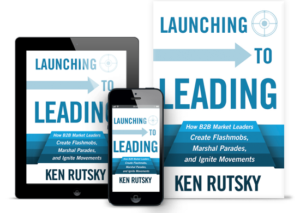 Ken Rutsky’s new book, Launching to Leading, is now available from Amazon and other book retailers. Launching to Leading explains how and why market leaders succeed in breaking through and leading in today’s crowded markets, and reveals how to apply this to your business to take you from Launching to Leading and beyond. Learn more on Ken’s book page!
Ken Rutsky’s new book, Launching to Leading, is now available from Amazon and other book retailers. Launching to Leading explains how and why market leaders succeed in breaking through and leading in today’s crowded markets, and reveals how to apply this to your business to take you from Launching to Leading and beyond. Learn more on Ken’s book page!
The Website
It was a lot of fun working with Ken, a very dynamic and pro-active collaborator, on his site! We are thrilled with the way it turned out and are happy to report that Ken is as well.
Check out Ken’s new site to learn more:
Ken’s Blog
Speaking
Consulting
Book
Connect with Ken on Facebook, Twitter, or LinkedIn. Additionally, you can send him an email at ken@kjrassociates.com.
Interested in our book design or web design/development services? Contact us to learn more!
August 30, 2016
Three Keys to a Successful Author Website
It has been nearly six years since I finished school, but I still get that “let’s get down to business” feeling this time of year. As the Web Projects Manager at Weaving Influence, a lot of my business these days revolves around websites—the Weaving Influence website, our client’s websites, and the dozens of other websites that I interface with on a regular basis. We consider an author’s website to be the heart of their online influence and encourage every author to periodically take an honest look at their site and evaluate if it is serving their message and personal brand effectively.
There are so many types of websites out there; how can you know what’s important to focus on? By considering these three key elements, you can get your site in tip-top shape!
1. Easy on the Eyes
“Artistic, brilliant, and groundbreaking”—these are probably not the words you would use to describe the design of your website, and that’s okay. A great design does not need to contain a lot of bells and whistles. In fact, we recommend keeping your design fairly simple and straightforward. However, if your site fails to meet a basic standard of design, your business may suffer.
If you don’t know how to judge whether or not your design meets the mark, ask a few honest friends or colleagues what they think. It can also be useful to take a look at sites by those who are very successful in your field and see how yours measures up.
2. Content—It’s Where the Magic Happens
Our CEO Becky Robinson says, “the magic happens when you show up.” I am going to take this one step further with websites and add, “in your content” to that sentence. Your content should not just be words to fill space on the page, but rather a reflection of who you are—a professional in a relationship with your clients and anyone interested in your work.
Be succinct and to the point. When someone visits your website, they should be able to ascertain what you do and the benefit you provide within a few seconds. Your content should be true to who you are, but not all about you. Focus on your audience—how can you help them? What information can you include on your site that will provide real value?
Consider offering a free giveaway (known as a lead magnet) in exchange for an email address (your email list should be at the core of your online marketing strategy). This could be a chapter of your book, a quiz, or anything that will give potential clients a taste of what you have to offer.
Lastly, be engaging! Include photos, videos, testimonials, quotes—easy ways to help visitors to your site decide to stay and learn more.
3. Stay Up to Date
The last thing anyone wants to see when they click on a website are year-old blog posts, photos from six years ago, or worst of all, error messages. You should be reviewing your website quarterly, if not more often, to make sure that all information is current and engaging. Additionally, you should be doing regular updates to whatever platform you use (we use WordPress and recommend that clients update their plugins and themes monthly). If you are unable to commit to posting on your blog at least once a month, I would recommend removing it entirely, at least from the navigation of your site.
And even if you still have not made the jump to a smart phone, your website should have long ago! Most pages are now viewed on a mobile or tablet device. If your site is not mobile responsive, it is not relevant to most readers.
Even a website with a somewhat dated look can remain engaging, if the content and media is fresh and relevant.
These three keys will help you unlock your website’s true potential! Keep your online home clean and tidy and your visitors will be happy to stay for a while.
Need help with your website? We’d love to help! Contact us for more information about our web services.
Image credit: alicephoto / 123RF Stock Photo
August 26, 2016
Featured on Friday: #ChasingRelevance with @dannegroni
As much as I sometimes hate to admit it, I am a millennial. My generation has such a lousy stereotype: we are (supposedly) lazy with a huge sense of entitlement, always looking for the best deal in work or other realms, desperate for favorable feedback, disdainful of traditional or old-school methods, and basically me-centric in every way.
I respectfully disagree. While there is always a legitimate reason for most stereotypes, I know — and work with — plenty of millennials who are hard-working, steadfastly loyal to their employers and coworkers, disciplined and persistent in pursuing goals and dreams, and generous to a fault.
I suppose it’s true of every generation as they come of age and start to dominate the workforce, but we millennials are remarkably misunderstood. And yet those of us who are misunderstood are typically so busy keeping our heads down with work and other profitable endeavors that we need someone to speak up for us. Enter Dan Negroni, and his new book about breaking down these myths and truly learning to understand and connect with my generation.
“Millennials are not a problem to be solved, they are an opportunity that needs to be embraced.” – Dan Negroni
Meet Dan Negroni
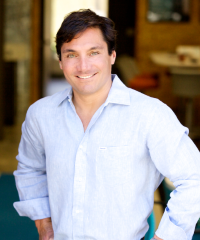
Dan is the quintessential next-generation business management and talent development consultant and coach solving today’s critical cross-generational issues. He leverages his authentic, no-nonsense approach and experience as a CEO, attorney, senior sales and marketing executive, to help companies bridge the gap between managers and their millennial workforce to increase employee engagement, productivity, and profits. Dan is the founder and CEO of launchbox, a corporate training, consulting and coaching firm focused on creating next generation leaders. He has also served as CEO for start-up businesses in the health and fitness market and for a national consulting firm, as well as holding senior roles in sales, marketing and operations for a variety of service businesses in the technology industry. As an expert and author on managing and creating next generation leaders, Dan is also a frequent keynote presenter at all types of management and millennial-related events including corporate gatherings, association conferences, industry events and sales meetings.
He resides in Del Mar, California, with his wife of 25 years and the youngest of his three children, and is an avid health and fitness nut, running, biking, swimming and doing anything else he can to fight off looking his age. Read more at chasingrelevance.com, and connect with him on Twitter @dannegroni.
Discover ‘Chasing Relevance’
“Chasing Relevance is not only about Millennials. It’s about all of us working to connect with each other and to bridge the gaps between the generations for the greater good. With bold language and a powerful model, Dan Negroni urges readers to genuinely care, communicate, and build relationships from the inside out. Because to serve others, we must first understand ourselves.”
—Ken Blanchard, co-author of The New One Minute Manager® and Collaboration Begins With You
Today there are more than 83 million millennials in the United States, representing 36% of our workforce. By 2025, that number will grow to 75%. If millennials are not your employees yet, they will be soon — as well as your biggest customers. Our ability to attract, train, manage, and retain this next generation of leaders is critical to the future success of our businesses. But a huge and damaging connection, communication, and understanding gap exists between non-millennials and millennials in our workplaces. Why? Because millennials are not a problem that needs to be fixed, they are an opportunity that needs to be embraced.
We must all find relevance in bridging the gap to create next-generation leaders, and that’s what Chasing Relevance is about: empowering businesses and their leaders by bringing together youth and experience to create powerful, connected workplaces. It’s time to stop chasing relevance and learn to truly understand, engage, and maximize your millennial employees and customers.
Check out what some of our Buzz Builders have to say about Chasing Relevance…
“You will learn a lot from this book. Some will apply to you and some will apply to how you can help millennials. I’m sure you’ll find that you can learn more going through it a second or third time.” {Read the rest of R. McConaughy‘s review on Amazon.}
“Working from the inside out with Dan’s guidance was fun for me. He guides us through a journey to better understand ourselves by examining 5 key points . . . After reflecting on these areas and really doing some homework on ME, I felt refreshed because I understand myself more clearly and better understand what I can bring to the lives of others via leadership or through mentoring. Dan led me down a path to put into action what I learned from inside me to influence those ‘outside.’” {See what else Lisa Kosak shares in her review.}
“Dan Negroni has hit that sweet spot in enabling us to see Millennials through a better frame than what we’ve attempted to do previously.” {Read more of Paul LaRue‘s review here.}
Learn More about ‘Chasing Relevance’ in the Webinar
What is your company doing to stay relevant, connect, and drive engagement with the next generation? Dan Negroni recently joined us for an interview to discuss the dramatic shift currently taking place in the workplace and marketplace. Among other things, he shared key trends that define the millennial generation; steps to bridge the generational gap; how to deliver value to connect with customers and employees; and how to stay relevant in a crazy, fast-changing world.
Did you miss it? Watch it free here.
Support the Launch
Buy the book if you haven’t already! (Amazon: US | Canada | UK | Australia)
Leave a review — we love reviews, and can never see enough of them on Amazon!
Write about it on your blog and send us the link so we can share it.
Share the graphics & tweets from the book site through your social channels.
Add it to your Goodreads shelf for others to find.
August 23, 2016
Is it Time to Give Your Social Accounts a Refresh?
Even if you don’t have children, you’ve probably noticed the back-to-school sales and first day of school pictures on your Facebook feed. Summer is winding down. Days are getting shorter. Nights are getting cooler. Well, not where I live in Northern Virginia, but I hear that in some parts of the country nights are getting cooler and fall is coming.
While I’m not in school currently and I don’t have children of my own, I still find that the back-to-school season is a great time to reassess and refresh. We talked recently about this being a great time of year to set goals.
It is also a great time to clean and purge both your physical space and your online space.
We recommend taking a look at your social media profiles three to four times per year to make sure that everything is up-to-date. What does that mean in practice? Here are a few areas to focus on:
1. Your Profile Photo:
Be honest – is your profile photo an accurate representation of who you are now? If your profile photo is from 15 years ago, it might be time to get a new headshot. If a professional photographer is beyond your means, chances are a friend or teenager you know can at least take a picture that is professional and clean.
If you want to take it a step further, a service such as Photo Feeler will allow you to upload several photos and get unbiased ratings on what your profile photo conveys about you.
2. Your Cover or Header Photos:
After you look at your profile photo, be sure to check out your cover photo. Is the photo still an accurate representation of you, your brand, or your product? If you’ve had the same header photo for over a year, it may be time to update to make your profile more fresh and appealing.
If you aren’t using a cover photo, why not add one? The cover photo or header is a great way to add more visual appeal and content to your profile. The right cover photo can also make you look more professional and help brand you.
3. Your Bio Section:
Once you’ve looked at the photos, it’s time to take a look at the language on your biographical information for each social channel. Is it up-to-date? Do you need to update any work or contact information? Are there any new publications, projects, or awards you want to add?
On LinkedIn, this process is a bit more intensive. Look at each work experience to make sure it accurately represents how you are trying to position yourself. Are there any new accomplishments you can add to your current position? Have you taken any classes or started any volunteer work? Be sure to add any new information and take off anything that is no longer relevant.
This three-step process shouldn’t take long. However, making sure your online profiles are up-to-date will go a long way in helping to establish you as a thought leader. tweet this
If you’d like more tips on leveraging LinkedIn to increase your thought leadership, download our free e-book!
Image credit: yupiramos / 123RF Stock Photo

